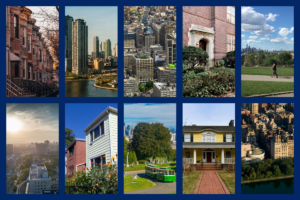Among the subsidized housing programs in New York City, Mitchell-Lama has provided affordable housing to tens of thousands of New Yorkers since its inception in 1955. Named after the two lawmakers who originated the legislation creating the program (New York State Senator MacNeil Mitchell and Assemblyman Alfred Lama), Mitchell-Lama buildings numbered 269 at the program’s peak in the 1960s and ‘70s.
The program is administered by the New York City Housing and Preservation Department and has offered income-restricted rentals and “limited equity” co-ops. With about 100,000 units in its heyday, Mitchell-Lama buildings and complexes were located in formerly blighted areas of Manhattan, including the Upper West Side, Chelsea, Lower East Side and in the Bronx, Queens and Brooklyn, too. Some prominent Mitchell-Lama complexes still exist, despite market forces that have led to privatization of some of the original complexes.
One example is the Independence Plaza North complex in Tribeca. With 1,260 apartments and townhouses located in three towers at 310 Greenwich Street, 40 Harrison Street and 80 North Moore Street, the complex was built in 1972 under the Mitchell-Lama rent-protection program. But the units are now transitioning to market-rate apartments, like this 3-bedroom, 1-bathroom unit at 310 Greenwich Street, which was listed for rent at market rates now of over $6,395 per month.
Rare Openings for Mitchell-Lama Housing
Sixty years after Mitchell-Lama arose, the number of apartment complexes, co-ops and other Mitchell-Lama program buildings has dropped significantly. Fewer than 45,000 units still exist in fewer than 75 Mitchell-Lama buildings.
According to New York State housing officials, the diminished supply of Mitchell-Lama housing is the result of owners or building boards opting to pay off mortgages and convert the buildings to market rate rentals or sales. Giving up the tax abatement and subsidies has proved lucrative for building owners, given the soaring real estate values in New York City. The loss of Mitchell-Lama housing opportunities is another reason why affordable housing in the state but particularly in NYC has grown to crisis proportions.
The New York City Housing Development Corporation, which holds mortgages on the existing Mitchell-Lama rental and cooperative housing developments, also holds a second program aimed to extend financing to Mitchell-Lama owners and co-ops to undercut costs for repairs. The incentive has worked to preserve some of the Mitchell-Lama stock, thus some New Yorkers have been able to live at a fraction of the cost of market-rate housing.
For instance, apartments that would normally sell for a million dollars in Chelsea would cost income-qualified residents $85,000. Rents are similarly rock-bottom and bear no relationship to market rates. That’s why Mitchell-Lama units are highly coveted, since tenants are said to move out “feet first.” Even when some tenants go on to exceed qualifying income levels, they opt to stay and pay a penalty fee. This is still far less expensive than market-rate apartments.
How to Get on a Waiting List
Only a few of the Mitchell-Lama buildings ever advertise that they have opened their waiting lists to allow more potential tenants to get in line. Waiting lists can last five to 10 years, with stories of frustration from some people who waited years to get into a Mitchell-Lama building, only to have their turn come up as the building switches out of the program, or is holding out vacant apartments in anticipation of moving the building out of the subsidy program. However, there are Mitchell-Lama developments with short waiting lists!
Still, if you have an income level that qualifies you and your family for a potential opening, it is worth exploring Mitchell-Lama buildings. (There’s Linden Plaza in Brooklyn; Dayton Towers in Rockaway; Woodstock Terrace in the Bronx and Franklin Plaza at 2085 Second Ave., as an example of Mitchell-Lama buildings that have had recent wait-list openings.)
Income Requirements for Mitchell-Lama
Be cautioned that there are lotteries merely to get on a long waiting list, but hey, this is New York. We’re used to a good challenge — and lines! Just keep in mind that family size and income are the two determining factors for eligibility. The range for co-ops is about $48,100 to $75,156 for a single person and $68,700 to $107,343 for a family of four. For rentals, income limits are set at seven times the annual rent, including utilities.
Newspaper and other public notices are used to advertise Mitchell-Lama buildings that are set to open their wait lists. This calls for you to mail a postcard with your name and address, details of which are posted. You apply to each Mitchell-Lama building individually, so it is good to check all listings since there is no central clearinghouse for applicants.
The general rule is that if you’re willing to apply in Mitchell-Lama buildings in far-flung places like Rockaway Beach or the Bronx, that significantly increases your chances of getting to the top of the list one day. Competing for Mitchell-Lama buildings in the UWS or Chelsea is going to make this a long, frustrating process. Likewise, the smaller the unit you request, the better chance you have to potentially, maybe, one day get a Mitchell-Lama unit. The bigger apartments are prized and tend to be inhabited by long-time residents.
Here is a list of Mitchell-Lama Complexes, most of which have tenants associations:
Bethune Towers
Castleton Park
Central Park Gardens
Clayton Apartments.
Coalition to Save Affordable
Housing of Co-op City
Concerned Tenants of Sea Park
East, Inc.
Concourse Village
Dennis Lane Apartments
1199 Housing
Esplanade Gardens
Independence House Tenants Assn
Independence Plaza North
Jefferson Towers
Lindville Housing
Lincoln Amsterdam House
Manhattan Plaza
Marcus Garvey Village
Masaryk Towers Tenant Assn
Meadow Manor
Michangelo Apartments
109th St. Senior Citizen Plaza
158th St. & Riverside Dr. Housing
Parkside Development
Pratt Towers
Promenade Apartments
RNA House
Riverbend Housing
River Terrace
River View Towers
Ryerson Towers
Starrett City Tenants Association
St. James Towers
Strykers Bay Co-op
Tivoli Towers
Tower West
Village East Towers
Washington Park SE Apartments
Washington Square SE Apartments
Westgate Tenants Association
West View Neighbors Association
West Village Houses
Woodstock Terrance Mutual










